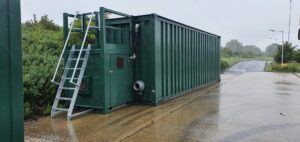Temporary biological treatment ensures compliance during refurbishment

Blockley village is within the Cotswold Area of Outstanding Natural Beauty (AONB) in Gloucestershire, UK.
Its wastewater treatment plant serves a population equivalent of 2,360 and is currently being refurbished by utility Severn Trent Water and construction contractor Galliford Try, which is managing the project.
Three WCSEE Hybrid-SAF™ - submerged aerated filter - units, with dedicated control panels and blowers, were selected to provide secondary biological treatment on a temporary basis, while two trickling filter beds were taken out of service for refurbishment.
Modular in design, with a 30% smaller footprint than comparable technologies, the SAF units are built offsite and can be transported easily. The patented process technology employs a submerged moving-bed, fixed-film reactor, proven to treat wastewater with greater energy efficiency compared to traditional submerged SAFs, and in a tighter site footprint.
At Blockley, the units are treating a peak flow of 27.5 l/s while meeting strict environmental permit requirements of 15mg/l biological oxygen demand (BOD) and 2.5mg/l ammonia.
WCSEE utilities manager Andrew Haywood said: “When a water company upgrades a wastewater treatment plant, the permit standards set by the Environment Agency remain the same. This ensures protection of the local water environment is never compromised, while parts of the site are taken offline.
“Therefore, to meet their obligations and avoid penalties, it is a priority for water companies and their contractors to bring in reliable technology to continue the treatment process – in this case for the secondary stage – while maintaining compliance.”
Luke Vardy, Galliford Try, project manager, said: “Galliford Try approached WCSEE early on in the Blockley scheme to produce a solution for temporary treatment requirements. Once installed, during the seeding period we allowed a 12-week time scale. The units seeded in just six weeks, saving time on the programme and allowing the refurbishment work to start sooner.”













